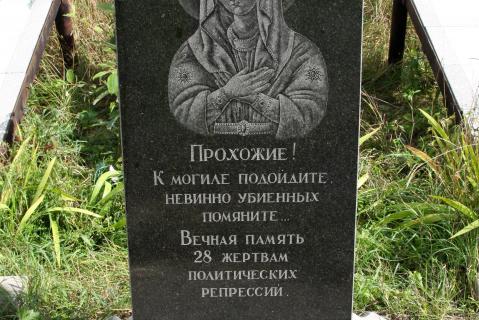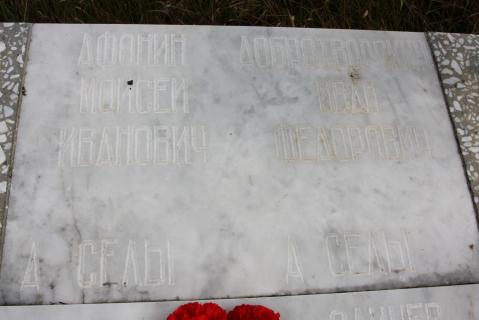In November 1918, in response to the Soviet regime’s introduction of agricultural dictatorship, a peasant uprising broke out in the Panikolsky district of the Belsk uyezd. On 15 and 24 November 28 peasants from the village of Syoly and other surrounding settlements were shot, on the orders of the Tver and Belsk Cheka, for active participation in the uprising. The bodies of the executed peasants were buried in ravines at the foot of the hill on which the Syoly village graveyard stands.
In 2003, the peasants accused of taking part in the uprising were officially rehabilitated. In 2006, thanks to their relatives and the inhabitants of Syoly and neighbouring villages a monument was erected on the site of their burial. The dedication reads: “Approach and pray for the slain innocents. May these 28 victims of political repression never be forgotten”. The names of those shot are engraved on separate plaques.
The Memorial online database (2025) lists 15,980 victims from the Tver Region (BR 10,099). See Tver cemetery.
The Kalinin Region Book of Remembrance names 4,225 who were shot, most during the Great Terror (3,665) but none in 1918. Charges against another 1,286 were dropped; 92 of them died in custody.
Police records add many more local families and individuals (total 5,881), almost all of whom were “dekulakised”: three quarters were deported to other parts of the country in 1930-1931.
| Date | Nature of ceremonies | Organiser or responsible person | Participants | Frequency |
|---|---|---|---|---|
|
30 October
|
Remembrance Day for the Victims of Political Repression
|
nk
|
Inhabitants of Syoly and surrounding villages
|
Annual event
|
| State of burials | Area | Boundaries |
|---|---|---|
|
burials preserved
|
memorial square 3.5 sq m
|
the square is fenced off
|
[ original texts and hyperlinks ]
“Was there an uprising in Syoly?” Znamya kommunizma, 13 September 1990
V. Tsvetkov, “Memory revived in stone”, Gorodskie vesti, 30 November 2006
“Syoly village”, Visit the Tver Region website
“Memorials to the victims of political repression in the former Soviet Union [a database]”, the Andrei Sakharov Museum & Public Centre [retrieved, 29 May 2022]
“Burial site of executed participants in the 1918 Panikolsky Uprising”, Virtual Museum of the Gulag [retrieved, 29 May 2022; no longer accessible]




